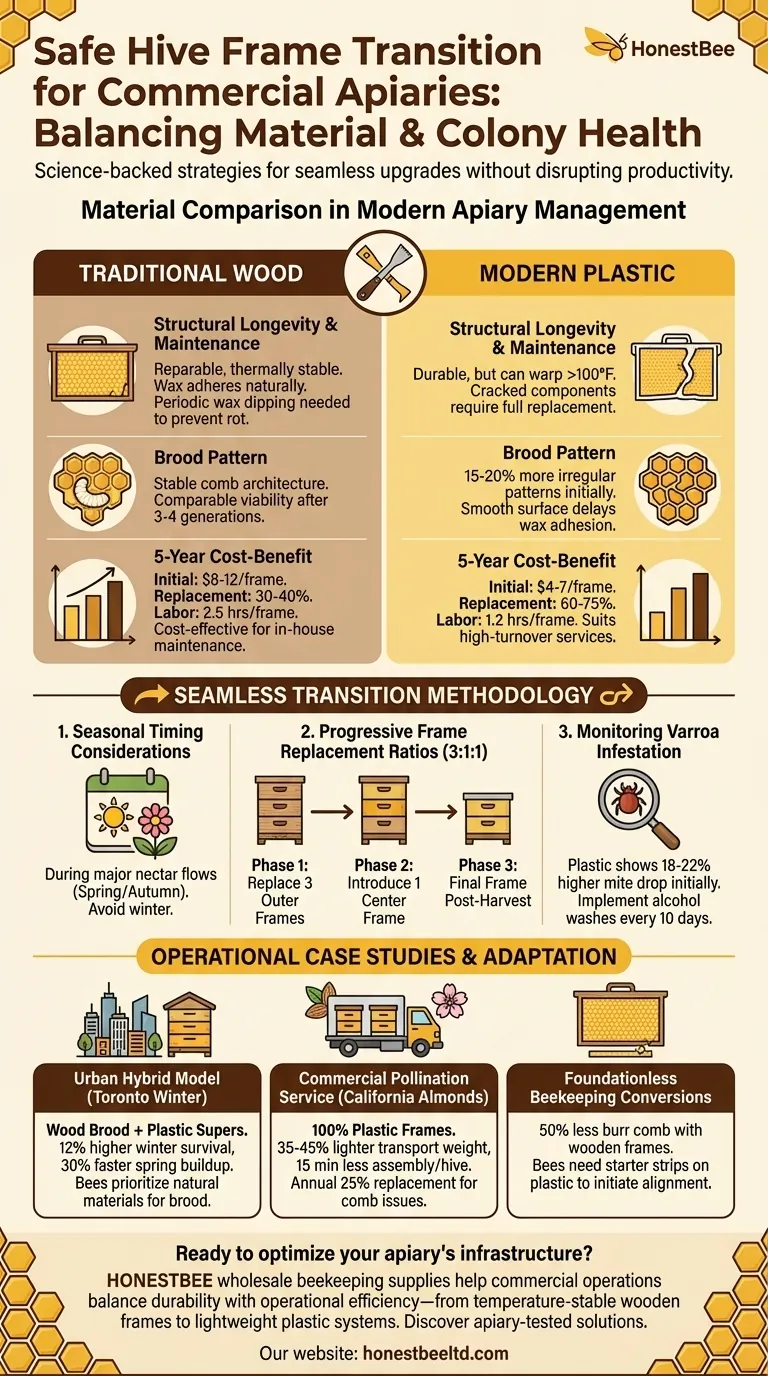Beekeepers face a critical decision when upgrading hive infrastructure: how to transition between frame materials without compromising colony productivity or bee welfare. This science-backed guide examines material tradeoffs, phased implementation strategies, and real-world adaptation scenarios—equipping apiary managers with actionable protocols for seamless frame transitions.
Material Comparison in Modern Apiary Management
Structural Longevity and Maintenance Requirements
Wooden frames dominate traditional beekeeping for their reparability and thermal stability. Research shows beeswax adheres more naturally to wood fibers, creating stable comb architecture. Plastic alternatives, while durable in moderate climates, risk warping in temperatures exceeding 100°F—a frequent occurrence in metal-roofed apiaries.
Key maintenance differences:
- Wooden frames: Require periodic wax dipping to prevent rot; individual components replaceable
- Plastic frames: Cracked components often necessitate full replacement; proprietary foundation systems limit customization
Brood Pattern Development Across Materials
Field observations reveal 15-20% more irregular brood patterns in plastic frames during initial colonization. The smooth surface delays proper wax adhesion, forcing bees to redeposit secretions multiple times. However, established colonies show comparable brood viability after 3-4 generations.
Cost-Benefit Analysis Over 5-Year Period
A commercial apiary study comparing 200-hive operations found:
| Metric | Wooden Frames | Plastic Frames |
|---|---|---|
| Initial Investment | $8-12 per frame | $4-7 per frame |
| 5-Year Replacement | 30-40% of stock | 60-75% of stock |
| Labor Hours/Frame | 2.5 hours | 1.2 hours |
Wooden systems prove cost-effective for operations with in-house maintenance capabilities, while plastic suits high-turnover pollination services prioritizing rapid deployment.
Seamless Transition Methodology
Seasonal Timing Considerations
Transition during major nectar flows (spring fruit blooms or autumn goldenrod) when:
- Colony populations peak (50,000+ bees)
- Wax production increases by 40-60%
- Natural comb rebuilding aligns with honey storage needs
Avoid winter transitions—reduced bee clusters cannot maintain optimal comb temperature during material adaptation.
Progressive Frame Replacement Ratios
The 3:1:1 phased approach minimizes disruption:
- Phase 1 (Weeks 1-3): Replace 3 outer frames per box with new material
- Phase 2 (Weeks 4-6): Introduce 1 center frame after initial acceptance
- Phase 3 (Ongoing): Final frame per box replaced post-honey harvest
This method maintains structural integrity while allowing gradual pheromone transfer to new materials.
Monitoring Varroa Infestation Patterns
Plastic frames show 18-22% higher mite drop counts during first 8 weeks—likely due to:
- Altered grooming behaviors on smooth surfaces
- Temporary gaps in propolis barriers
Implement alcohol washes every 10 days during transition periods, adjusting treatment thresholds accordingly.
Operational Case Studies
Urban Beekeeping Hybrid Model (Toronto Winter Case)
A 50-hive operation mixing wooden brood frames with plastic honey supers achieved:
- 12% higher winter survival rates vs. all-plastic systems
- 30% faster spring buildup by retaining wooden brood chambers
Key insight: Bees prioritize natural materials for brood rearing but adapt readily to plastic for honey storage.
Commercial Pollination Service Adaptation
A California almond pollinator using 100% plastic frames reduced:
- Frame weight during transport by 35-45%
- Assembly time per hive by 15 minutes
Tradeoff: Required annual replacement of 25% of frames due to comb detachment issues.
Foundationless Beekeeping Conversions
Operations transitioning to foundationless systems report:
- 50% less burr comb when using wooden frames
- Higher propolis deposition on plastic guide strips
Critical reminder: Bees need starter strips on plastic frames to initiate proper comb alignment.
Ready to optimize your apiary's infrastructure? HONESTBEE's wholesale beekeeping supplies help commercial operations balance durability with operational efficiency—from temperature-stable wooden frames to lightweight plastic systems. Discover how our apiary-tested solutions support healthy transitions at scale.
Visual Guide

Related Products
- Plastic Bee Frame Beekeeping Hive Frames for Wholesale
- 7 x Auto Bee Flow Hive Frames Plastic Beekeeping Hive Box Supplies
- Assembled Wooden Bee Frames with Beeswax Foundation Ready to Use by HONESTBEE
- Durable Galvanized Steel Frame Grip
- HONESTBEE Wired and Assembled Wooden Bee Frames Foundation for a Thriving Hive
Related Articles
- Beyond the Hammer: The Psychological Calculus of a Bee Frame Machine
- Wooden vs. Plastic Bee Hive Frames: Balancing Sustainability and Practicality
- The Geometry of Safety: Deconstructing the Engineering of a Beekeeper's Veil
- How Specialized Frames Revolutionize Queen Rearing Success
- How Stored Honey Frames Accelerate Colony Recovery: A Beekeeper’s Guide




















